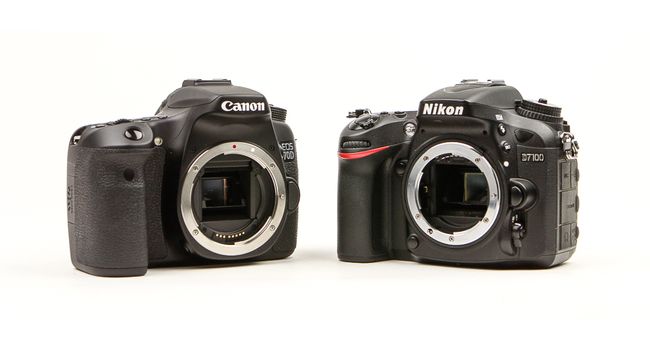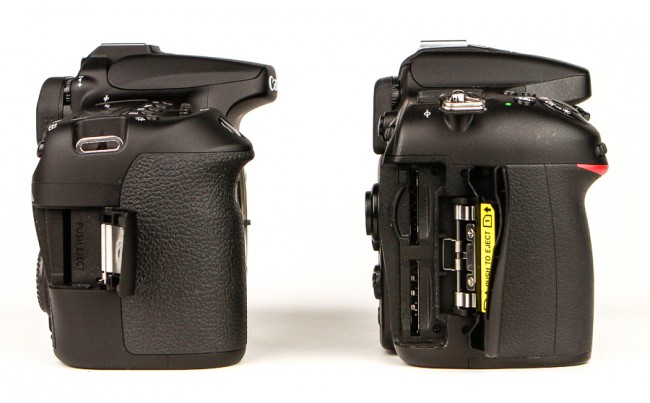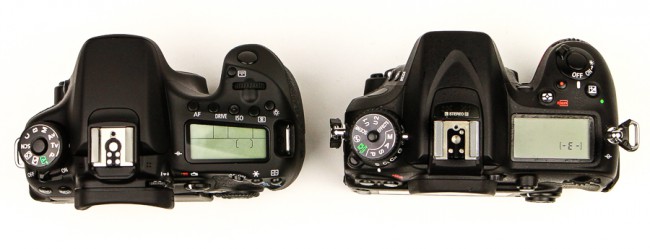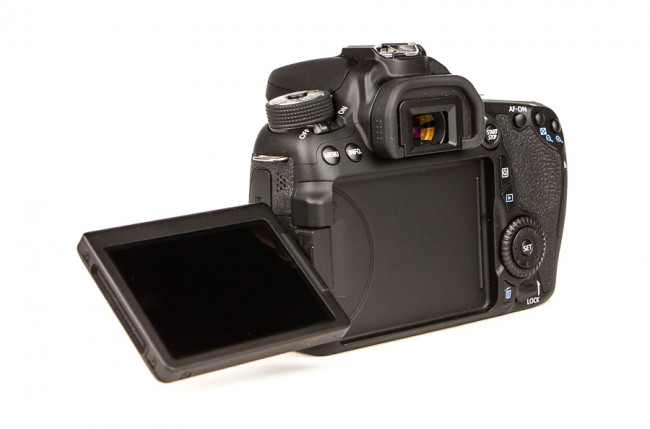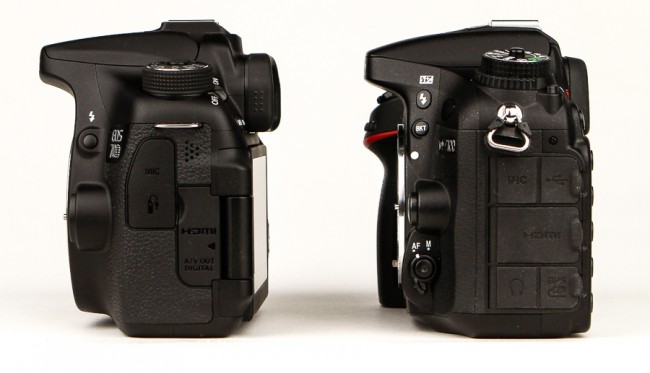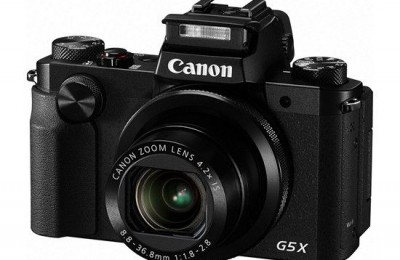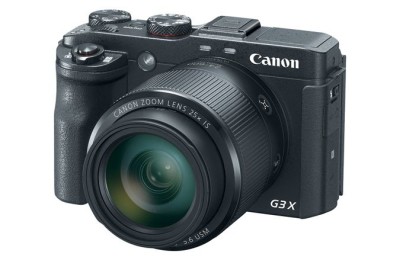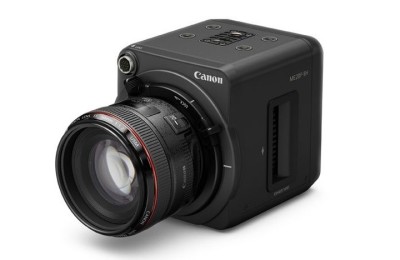Despite the emergence of several full-frame models from the major manufacturers of photographic equipment, apparatus with APS-C-matrices is still dominating the market SLR cameras and in steady demand among professionals and amateurs.
Test two top models – Canon 70D and Nikon D7100, will help answer the question of what to choose for serious photography.
Design and Ergonomics
Our current experimental very similar in weight and dimensions. For Canon 70D is 139x104x79 mm and 755 g, at Nikon D7100 – 136x107x76 mm and 755 g
Comfort hold roughly the same machines in the hand perfectly.
Approaches to the location and size of controls in different companies. Canon’s engineers prefer smaller buttons (if you shoot with gloves, this figure is set), the Nikon buttons in general are larger and spaced further, although the situation with joysticks – reverse.
The power switch is located under the wheel 70D select the metering modes, ie the left of the viewfinder, which means that one turn on the machine (right) hand, you can not. In D7100 switch surrounds the shutter button that is certainly convenient.
Wheels change the metering modes are equipped with a lock to prevent accidental rotation. By the way, this is one of those little nuances that distinguish vehicles for serious photographers from amateur cameras.
Setting shooting also differs. At Canon sensitivity change, change the drive mode and exposure compensation performed by a single entry on the right. The location of the second wheel around on the joystick on the rear panel seems to me not very convenient, especially if you are using a heavy lens – Nikon approach here seems more appropriate in terms of ergonomics, but it’s certainly a subjective factor.
In D7100 right input only exposure compensation, but the drive mode controls the wheel located coaxially with the mode dial metering. To change the sensitivity requires pressing and holding the left hand (she is on the left of the LCD), turning the wheel right, the Canon just click on the button with your left hand to change the sensitivity of the wheel and the button is pressed again.
By the number of hardware buttons with a minimum margin leads Nikon (18 versus 17). Overall control of the additional parameters competitors about the same.
Viewfinder 70D covers 98% of the area of the future frame, and provides a 0.95 x magnification, whereas D7100 – 100 and 0.94 x%. Light transmission, of course, to a large extent depends on the lens, but Nikon viewfinder visually lighter. This fragment picture with measurements in Photoshop CC figures confirms this.
The competition LCDs is hardly a clear winner. On the side of Canon – a distinct advantage swivel design with two degrees of freedom and a certain advantage in sensitivity to touch. The downside, in terms of image, are “stretched” proportions (3:2).
Nikon boasts larger diagonal (3.2 inches vs. 3) and a large number of picture elements (1228800 vs 1040000) and aspect ratio (4:3) is best combined with the concept of classical photography.
D7100 display brighter than the 70D – affects the presence of additional “white” pixel. This is particularly noticeable when shooting in bright sunlight.
However rigid embedding LCD screen into the rear panel now looks obvious anachronism.
Memory card installed in the slot, hidden under the cover on the right side of the casing. In D7100 complete superiority: two sockets, the user can assign the file allocation at its discretion: the transition to the second card after completing the first unfolding RAW and JPEG on different cards or duplication of information at critical shooting.
Both devices are protected from moisture and dust. Finishing materials are similar, but the texture on the Canon linings of his right hand more pronounced. Build quality – perfect, about any backlash and squeaks no question.
Features and functionality
At this stage of the way the two leading manufacturers diverged.
Canon has equipped the new matrix 70D Dual Pixel CMOS AF with 20.2-megapixel main difference from all the others – dvuhdiodnye cells for each pixel. Division between “right” and “left” half allowed to collect information about the phase each pixel – with 80% of the matrix.
First phase in a matrix of sensors deployed company Fujifilm, but they were few. Even in the latest versions of X-Trans CMOS II they are much smaller than the actual pixels.
Canon solution avoids the need to interpolate the information to fill in the blanks on the phase in the image sensor, which is certainly a positive effect on detail.
In practice, this means that the mode LiveView (with photo and movie), when the mirror is raised and the light is only on the matrix, the camera continues to receive phase information and uses it to focus.
As you know, for about 30 years autofocus lenses designed to work in conjunction with the phase is focusing system. They, of course, working with the “contrast” system, but slower.
It should be noted that recent advances mirrorless cameras almost leveled the difference in the speed and accuracy of focus, but this is true only for specially designed for the “contrast” of the system lenses.
The phase information is important primarily for use by the existing fleet of optics. According to Canon, 70D focus system is fully compatible with 103 models mount lenses EF, issued over the years.
Simultaneous operation of the phase system with other algorithms (primarily – Face Detection) allows to increase the reliability in the zone of sharpness retention of key objects of the frame.
Mistakenly believe that the main prize given to those who engaged in shooting video. Yes, smooth Focusing when zooming or changing the position of the object relative to the camera – an obvious plus. But photographers win.
First, the problem of lack of focus points disappears – instead of specific areas of the sensor design employs 80% of the frame. Those who shoot with a tripod, appreciate innovation appreciated.
Secondly, the need for cross-type sensors Void – pixels collecting phase information, so much that at any position of the camera / light source it is enough to focus.
Finally, expanding the range of exposure, in which AF occurs quickly and accurately. Again, quantity is transformed into quality.
In this joyful picture there is only one “but.” SLR camera design. Pros Dual Pixel appear only in the mode of Live View, ie when the mirror is raised. In this optical viewfinder stops working, the image displayed on the LCD display. Yes, it is possible to turn / tilt when shooting in bright sunlight, but in many cases “look through the peephole” somehow familiar and comfortable.
In normal mode, data is used to focus the traditional 19-point sensor which all the elements – cruciform.
Although specifically AF accuracy in “regular” and “new” modes has not been tested under the impression that the Dual Pixel provides the best results, but to really feel the difference, it is necessary to use the optics of the L-series.
To compensate for the shortcomings of specific instances of Canon offers to introduce a correction + / – 20 steps. The camera can store data for 40 (!) Lenses. If all optics “misses” the same, another menu prompts general amendment.
Nikon sets D7100 24,1-megapixel matrix without scouring the optical filter. At the beginning of 2014 was the highest on record for the number of pixels the sensor APS-C.
Trump card – detail. By using a good lens. As a bonus, Nikon offers to use information from the central region and earn extra crop factor of 1.3x. When recording video is interesting because of the “increasing” by 30% of the lens focal length (equivalent to 35mm an almost twofold increase in passport focal length) when photographing – AF points by placing a significant part of the frame and increasing the burst speed.
If we are talking about continuous shooting, the cameras provide roughly equal to the result. Canon 70D provides up to 7 / s, buffer allows up to 65 frames in JPEG or 16 RAW. Nikon’s all depends on the settings: JPEG and RAW 12-bit removed at speeds of up to 6 / s at full resolution, or 7 c / s when using the central region, 14-bit RAW – to 5 and 6 to the / s, respectively. In a buffer of up to 50 JPEG or 6 RAW at full resolution or 100 JPEG or RAW 7 with a crop factor of 1.3. Yes, Nikon still have scope for action. Expect two dozen 24-megapixel shots in the buffer would be enough, but for a 15-megapixel Kropa current value is clearly not enough.
To focus the Nikon has a phase sensor Multi-CAM 3500DX, it 51 points, 15 of them – cruciform. The photographer can choose how much – 9, 21 or 51 points will be used. Depends on the amount of accuracy and speed – dependent and directly proportional to the back respectively.
Location focus points in the frame at least correct. Unlike full-frame vehicles, where they are concentrated in the center, at D7100 covered significant area of the frame. And if you use only the central region of the sensor, you get almost perfect distribution.
Key indicators, including shutter speed range (up to 1/8000), the speed flash sync, etc., allow to carry 70D and D7100 in the category of professional equipment. Batteries according to the manufacturer, provide nearly a thousand shots on a single charge.
Both cameras have a number of small but interesting “chips”.
For filming in silence (eg, concerts of classical and jazz music, the theater or a meeting of senior officials) Canon offers mode Silent shutter. This is not completely noiseless technology – mechanical shutter still produces a characteristic sound, but it really is quieter than usual.
Nikon’s white balance adjustment appeared on a small sample – spot white balance. For professional work very useful innovation: it is enough to put in a frame “camp” gray card and point to it in the mode of Live View: all camera now knows about the temperature of the light. Conventional systems require significant filling of the frame or allow to carry out this setting at the stage of post-processing RAW.
The quality of images
Over the past few years the development of technology has led to the fact that a “reasonable” range of the camera’s sensitivity classmates give very similar results in terms of noise and color rendering.
This means that today, as in the film era, the cornerstone should put the quality (not just resolution, but also a “picture”) optics.
However, the matrix provides a Nikon unit advantage – 20% “extra” pixels allow freer or more crop scale picture when printing. Add the lack of blur filter, and the result is 70D have much strain to the result was the same.
ISO 1600 Canon 70D do it, and then the difference becomes noticeable with careful consideration. The pictures made D7100, in the shadows a little more useful information, it is slightly wider dynamic range.
Saturated colors, especially red, the Nikon looks correct. With increasing sensitivity difference increases. To white balance in normal conditions no complaints.
Given the widest possibilities fine tuning (including color, saturation, sharpening and noise reduction) can safely say that both competitors perform their main function – photography as “excellent.”
Processing RAW opens up real opportunities cameras. Underexposure in three stages compensated, while even at ISO 3200 noise growth does not harm the image irreparably. Of course, for large format printing, it is not necessary, but looks great, for example, in the photo book of the other pictures on the page or in social networks.
Relight two EV steps to fix that, too, but will have trouble over yellow.
For high-contrast scenes – for example, in wedding photography – such “resistance” highly valued.
Verdict
Any clear answer to the question “what is better – Canon or Nikon?» Did not exist at least in the digital era. In two fotostolpov technology has advantages and disadvantages. 70D and D7100 have made the task even more difficult search leader.
Canon 70D – great camera, easy to use, compact and lightweight enough. Technology Dual Pixel CMOS AF may well be an important milestone in the development of the industry as a whole. Knowing the commitment of many videographers Technology Canon, we can safely assume that the 70D will be in demand, especially in view of smoothness and accuracy of focusing when shooting video.
The presence of Wi-Fi-module today is not in itself an advantage, but Canon has implemented remotely control some shooting settings, and this is a plus.
Finally, swivel LCD screen 70D is much more convenient built-in display D7100.
However, Canon gives the details. On the scales in favor of the Nikon and the number of pixels, and no optical blur filter, and 100% coverage of the area of the future frame and two slots for memory cards. Add another opportunity to monitor the sound through headphones while shooting video and recording uncompressed signal to an external recorder via HDMI.
Is defeated Nikon D7100? Not quite … If you need Wi-Fi, you’ll need to buy an external unit. LCD Screen tightly integrated into the rear panel. RAW buffer size even for a 15-megapixel frames inexcusably small.
The final choice depends on many factors. Extremely important price, quality and availability of lenses. Before you decide, do not forget to analyze the current state of the market for optics Canon and Nikon.
Read another very interesting article about alternative energy of the Sun, water and air.

